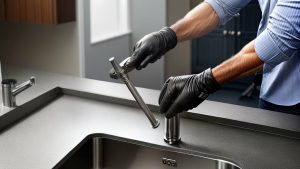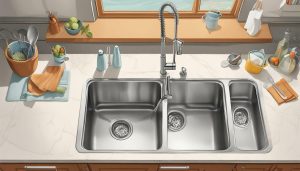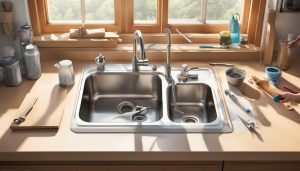Accurate measurements are a crucial component of any kitchen renovation project, especially when it comes to installing new cabinets. Measuring your kitchen cabinets correctly ensures they fit perfectly and look aesthetically pleasing. A kitchen renovation can be a significant investment, so you want to ensure that you get accurate measurements before purchasing new cabinets.
Key Takeaways
- Accurate measurements are crucial for the success of a kitchen renovation project.
- Measuring correctly ensures your cabinets fit perfectly and look aesthetically pleasing.
- Before purchasing new cabinets, it’s essential to get accurate measurements to avoid any installation problems.
Why Accurate Measurements are Important for Kitchen Cabinet Installation
Accurate measurements are crucial for a successful kitchen cabinet installation. When measurements are off by even a small amount, it can lead to ill-fitting cabinets that are both dysfunctional and aesthetically unpleasing. In this section, we will discuss the best practices for measuring kitchen cabinets and why they are so important.
Measuring Tips for Accurate Kitchen Cabinet Measurements
To ensure accurate measurements, there are several tips and best practices to keep in mind. The first is to always use a high-quality measuring tape that is specifically designed for construction projects. A tape that is too flimsy or inaccurate can lead to incorrect measurements and ultimately, poorly fitting cabinets.
Another important tip is to measure twice, or even three times, to ensure precision. It’s also crucial to take into account any angles or irregularities in the kitchen, such as uneven walls or floors. Measuring these areas accurately may require additional tools, such as a level or angle finder.
Finally, it’s important to account for any appliances or fixtures that will be part of the kitchen layout. These items can significantly impact the measurements needed for cabinets, and failure to consider them can lead to costly mistakes during installation.
Benefits of Accurate Kitchen Cabinet Measurements
Accurate measurements are essential for kitchen cabinet installation for several reasons. First and foremost, fitting cabinets precisely ensures they will be both functional and aesthetically pleasing. Poorly fitting cabinets can create gaps or overhangs that compromise the overall look and feel of the kitchen.
In addition, accurate measurements can prevent other costly mistakes down the road. For example, if cabinets are too large for the space, it may require costly modifications to the kitchen’s structure or other fixtures. Accurate measurements can prevent these types of errors and ultimately save time and money.
Overall, taking the time to get accurate measurements before beginning a kitchen renovation project can help ensure a smooth process and a beautiful end result.
Step-by-Step Guide: How to Measure for New Kitchen Cabinets
Measuring for new kitchen cabinets can seem daunting, but by following these simple steps, you can ensure accurate measurements and a successful kitchen renovation.
- Prepare the space: Clear out any existing cabinets, appliances, and other fixtures in the area where the new cabinets will be installed. This will provide a clear space for accurate measurements and minimize any obstacles that can affect the process.
- Choose your measuring tools: Essential tools for measuring kitchen cabinets include a measuring tape, level, and pencil for marking measurements. It’s essential to use precise tools to ensure accurate measurements.
- Measure the width: Determine the width of the cabinet space by measuring the distance between the two adjacent walls where the cabinets will be installed. Measure in three different places: the top, middle, and bottom of the wall. Record the narrowest measurement for accurate fitting.
- Measure the height: Measure the height of the cabinet space by measuring from the floor to the ceiling in at least three different locations: the left side, the center, and the right side. Record the shortest measurement to ensure cabinets fit properly.
- Measure the depth: Determine the depth of the cabinet space by measuring from the back wall to the front edge of the countertop. Record the measurement in inches.
- Account for appliances and fixtures: If you’re planning on keeping existing appliances or fixtures, measure their height and width, and factor in space for clearance around them. This will prevent cabinets from interfering with their functionality.
- Record and document measurements: Use a notebook or spreadsheet to record all measurements. Label each measurement clearly to prevent confusion during installation. Double-check all measurements to ensure accuracy.
By following these steps and taking accurate measurements, you can ensure a successful installation of your new kitchen cabinets. Don’t rush the process, take your time, and seek professional assistance if necessary for precise measurements.
Tools and Equipment for Accurate Measurements
Having the right tools and equipment is essential for accurate measurements when installing new kitchen cabinets. Here are some items that can help you measure accurately:
- Measuring tape: A high-quality measuring tape is necessary for precise measurements. Look for one that is at least 25 feet long with a locking mechanism.
- Level: A level is important for ensuring that your cabinets are hung evenly. Invest in a good quality level that is long enough to span the width of your cabinets.
- Pencil and paper: Taking notes and sketches during the measuring process will help you keep track of the dimensions and placement of your cabinets.
- Cordless drill: A cordless drill will ensure that you can drill holes for fastening screws without worrying about power sources.
- Hacksaw or jigsaw: A saw is necessary for cutting any necessary holes for appliances, as well as cutting trim pieces to fit.
Having these tools and equipment on hand will help you measure your kitchen cabinets accurately for a successful installation.
Measuring Cabinet Width, Height, and Depth
Measuring the width, height, and depth of your cabinets is crucial to ensure they fit perfectly in your kitchen. Here are the steps to take accurate measurements:
- Measure the width: Use a measuring tape to measure the distance between the left and right walls where the cabinet will be installed. Make sure to measure in multiple locations to account for any unevenness in the walls. Record the shortest measurement to ensure the cabinet fits.
- Measure the height: Measure the distance between the floor and ceiling where the cabinet will be installed. Again, measure in multiple locations and record the shortest measurement for accuracy.
- Measure the depth: Measure the distance from the back wall to the front edge of the countertop where the cabinet will be installed. This will ensure the cabinet doesn’t interfere with any existing fixtures, like a sink. Record the measurement for accuracy.
Remember to account for any molding or trim that may sit on top of the cabinet, as this will increase the total height of the cabinet. Take measurements for the width, height, and depth of each cabinet, as they may vary depending on their location in your kitchen.
Measuring Cabinet Width, Height, and Depth
Accurately measuring the width, height, and depth of your kitchen cabinets is crucial to ensure a proper fit and functionality. Follow these steps for precise measurements:
- Measure the width: Start at the leftmost point of the cabinet and measure straight across to the rightmost point. Note any obstacles, such as walls or appliances, that may affect the width measurement.
- Measure the height: Measure from the highest point of the cabinet to the floor. If your cabinets will have a crown molding or other decorative feature, be sure to include it in your height measurement.
- Measure the depth: Measure from the back of the cabinet to the front edge of the door. Note any obstacles, such as countertops or appliances, that may affect the depth measurement.
It’s important to take accurate measurements, so be sure to measure multiple times and double-check your measurements to ensure they are correct. If you have any doubts about your ability to measure accurately, consider seeking professional assistance.
Recording and Documenting Measurements
When measuring for new kitchen cabinets, it’s essential to record and document all measurements accurately. This ensures that the cabinet installation process runs smoothly and without errors.
One useful tip for organizing your measurements is to create a diagram or rough sketch of your kitchen layout. This can help you keep track of the location of each cabinet and fixture, as well as the measurements for each.
Another important aspect to consider is labeling each measurement. Use clear and concise labels for each dimension to avoid confusion during the installation process. For example, label the height, width, and depth of each cabinet measurement.
Keeping a detailed record of all measurements is crucial for precision and accuracy. By documenting your measurements, you can easily refer back to them at any time and ensure that the installation is done correctly.
Lastly, it’s a good idea to double-check all measurements before proceeding with the installation process. This can help catch any errors or discrepancies, preventing potential issues down the line.
Seeking Professional Assistance for Precise Measurements
While measuring for new kitchen cabinets can seem like a straightforward task, it is not always easy to achieve accurate measurements. In some cases, it may be best to seek the assistance of a professional to ensure precise measurements for your kitchen renovation project.
An experienced professional will have the necessary tools and expertise to provide reliable measurements and ensure the proper fit of your new kitchen cabinets. Additionally, they can offer advice and guidance on the best practices for measuring your kitchen cabinets, as well as provide helpful tips for achieving accurate measurements.
If you are unsure about your ability to take accurate measurements, or if you want to ensure the best possible results for your kitchen renovation project, seeking professional guidance may be the right choice for you.
Keep in mind that while hiring a professional may incur additional costs, the benefits of accurate measurements and a successful kitchen renovation can far outweigh the expense.
Conclusion
Accurate measurements are critical in achieving a successful kitchen renovation and installation of new cabinets. A full understanding of the dimensions of your kitchen and appliances is necessary to ensure that cabinets fit properly and function efficiently. Remember to take measurements for width, height, and depth and account for appliances and other fixtures in the kitchen.
It is also essential to have the right tools and equipment, such as measuring tapes and levels, to ensure accuracy in measurements. Recording and documenting measurements is also crucial to ensure consistency and accuracy during the installation process.
Consider Seeking Professional Assistance
If you’re unsure about how to take precise measurements, consider seeking the help of a professional. They have the expertise and knowledge to ensure the measurements are accurate, reliable, and meet your needs. Ultimately, investing in precise measurements is worth it, as it can save you time, money, and frustration in the long run.
We hope this kitchen cabinet measurement guide has provided you with helpful tips and a step-by-step process for taking accurate measurements. Remember to measure twice and cut once, and you’ll be on your way to a beautiful and functional kitchen!
FAQ
Q: Why are accurate measurements important for kitchen cabinet installation?
A: Accurate measurements are crucial for kitchen cabinet installation to ensure the cabinets fit properly, function correctly, and look aesthetically pleasing.
Q: What is the step-by-step process for measuring for new kitchen cabinets?
A: The step-by-step guide for measuring new kitchen cabinets includes determining the cabinet width, height, and depth, accounting for appliances and other fixtures, and recording and documenting the measurements.
Q: What tools and equipment are needed for accurate measurements?
A: To ensure accurate measurements, you will need measuring tapes, levels, and other essential tools recommended for measuring kitchen cabinets.
Q: How do I measure the width, height, and depth of kitchen cabinets?
A: To measure the width, height, and depth of kitchen cabinets accurately, follow the instructions provided in the guide, which will break down the process into simple and easy-to-follow steps.
Q: Why is it important to account for appliances and other fixtures when measuring for kitchen cabinets?
A: Accounting for appliances and other fixtures is essential to ensure that the kitchen cabinets fit around existing elements in the kitchen and provide a seamless and functional design.
Q: How should I record and document the measurements?
A: Recording and documenting measurements is important to maintain accuracy during the cabinet installation process. The guide will provide suggestions on how to organize and keep track of measurements effectively.
Q: Should I consider seeking professional assistance for precise measurements?
A: Seeking professional assistance for precise measurements can be beneficial, as professionals have the expertise and experience to ensure accurate and reliable measurements for your kitchen cabinets.

It’s me, Amber Hayden, the heart and soul behind SagarmathaOnlineMedia.com. From a young age, I’ve been head over heels for everything home-related, from interior decor to gardening. I’m the type who can’t resist a well-crafted piece of furniture, and I firmly believe that a home isn’t complete without a pet or two. But it’s not just about creating pretty spaces for me. I’m all about making homes that tell a story reflecting the people living there. SagarmathaOnlineMedia.com is my way of sharing this passion with you. Whether you’re looking for tips to jazz up your living room, advice on pet care, or ideas to make your garden bloom, I’m here to help. So, let’s embark on this journey together and make your house a home!



